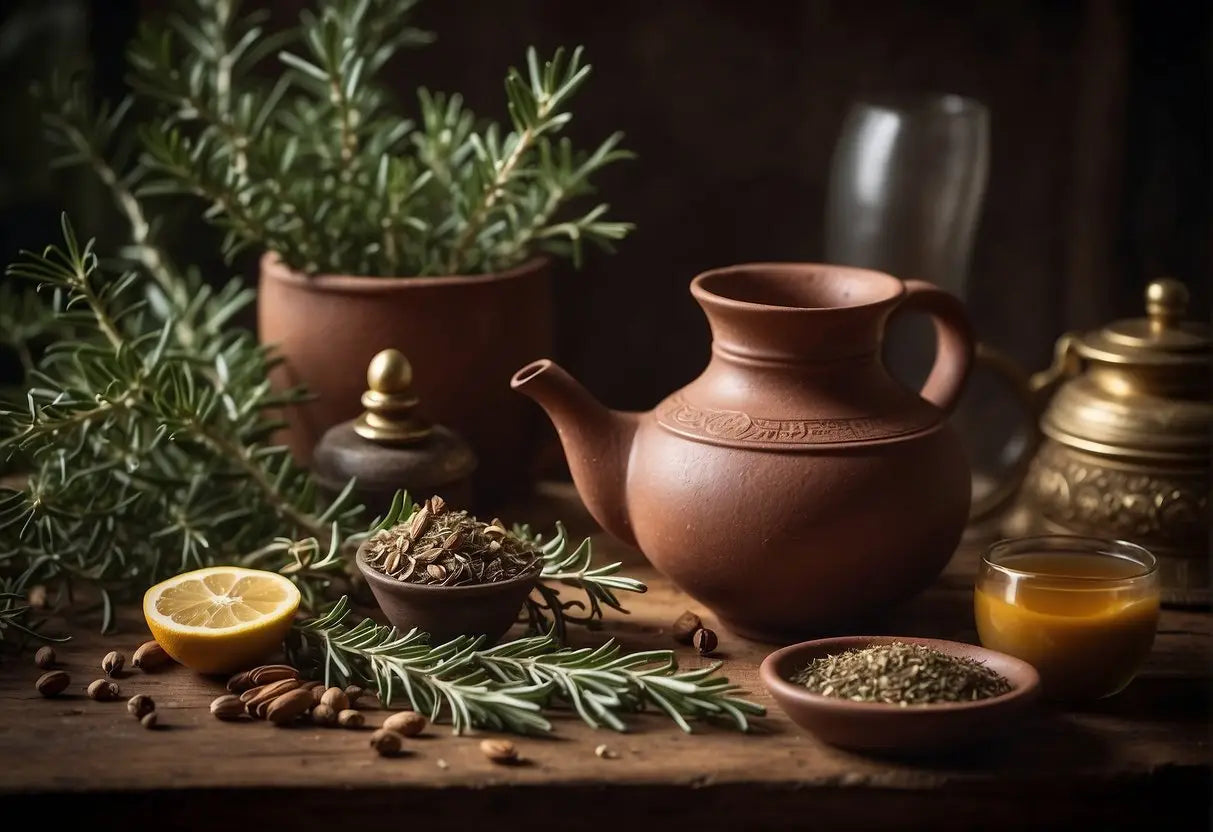Rosemary Tea
Rosemary tea is associated with several health benefits, from its potential to reduce oxidative stress to improving digestion. Here, you'll find specific ways rosemary tea may benefit your health.
Antioxidant Properties
Rosemary tea contains compounds with antioxidant effects. Antioxidants help protect your cells from damage by free radicals. Key components in rosemary, such as rosmarinic acid and carnosic acid, are responsible for these beneficial properties.
Cognitive Enhancement
Drinking rosemary tea might have a positive impact on your brain health. Research suggests that rosemary can improve cognitive function, especially in memory retention and alertness. This is attributed to certain compounds in rosemary that may act on your nervous system.
Bestsellers
Digestive Health
Your digestive system may also benefit from the ingestion of rosemary tea. It has been traditionally used to help with digestive disorders and to relieve symptoms such as bloating and gas. Its anti-inflammatory properties can contribute to the overall health of your digestive tract.
Stress and Anxiety Relief
The aroma of rosemary alone has been linked to reducing stress levels, and drinking rosemary tea might further help manage your stress and anxiety. The compound luteolin present in rosemary tea may have a calming effect on your nervous system, facilitating relaxation.
Preparation and Brewing
To brew rosemary tea, you will need fresh or dried rosemary leaves. The general recommendation is about one teaspoon of dried leaves or one tablespoon of fresh leaves per cup of water.
Ingredients:
- 1 teaspoon dried rosemary leaves or 1 tablespoon fresh leaves
- 1 cup of boiling water
Instructions:
- Boil water using a kettle or a saucepan.
- Place the rosemary leaves in a tea strainer or infuser.
- Pour the boiling water into a mug over the rosemary leaves.
- Let the tea steep for about 5 minutes. If you prefer a stronger flavor, you can steep for up to 10 minutes.
- Remove the strainer or infuser, or if you used loose leaves, strain the tea into another cup.
For optimal flavor, it's advisable to use a ceramic or glass cup to prevent the taste from being affected by the material of the vessel. Consider covering your mug while the tea is steeping to retain the essential oils and full aroma of the herb. Adjust the amount of rosemary to suit your taste preference. If desired, add a sweetener like honey or a slice of lemon for extra flavor.
Nutritional Profile

Rosemary tea is made from the leaves of the rosemary plant, a herb rich in vitamins, minerals, and antioxidants. This beverage offers a range of nutrients that may contribute to your overall health.
Vitamins and Minerals: Your cup of rosemary tea contains essential vitamins such as vitamin C, vitamin A, and a range of B-vitamins including folate. These vitamins play a crucial role in maintaining your immune system, vision, and skin health. The tea also provides minerals like iron, calcium, and magnesium, which are vital for maintaining strong bones, healthy blood cells, and proper muscle function.
Antioxidants: Rosemary tea is a good source of antioxidants like rosmarinic acid and carnosic acid. Antioxidants help your body fight off free radicals, which can cause oxidative stress and have been linked to chronic diseases.
Essential Oils: The essential oils found in rosemary, such as eucalyptol and camphor, are known for their anti-inflammatory properties and may aid in digestion and reducing stress.
| Nutrient | Benefit |
|---|---|
| Vitamin C | Immune system, skin health |
| Vitamin A | Vision, immune system |
| B-vitamins | Energy production |
| Iron | Healthy blood cells |
| Calcium | Bone strength |
| Magnesium | Nerve and muscle function |
| Antioxidants | Cellular protection |
| Essential Oils | Anti-inflammatory, digestion |
Including rosemary tea in your diet can be an enjoyable way to ingest nutrients that support your bodily functions. It's a caffeine-free alternative to traditional teas, making it suitable for consumption at any time of the day.
Lao Ban Zhang
Side Effects and Precautions

Before incorporating rosemary tea into your routine, it's important to be aware of potential side effects and necessary precautions. This herb can interact with medications and isn't recommended for certain groups.
Pregnancy and Breastfeeding
- Pregnancy: Rosemary in medicinal amounts is potentially unsafe during pregnancy. It may affect the uterus and could lead to miscarriage. Stick to food amounts.
- Breastfeeding: There is not enough reliable information about the safety of taking rosemary if you are breastfeeding. Stay on the safe side and avoid use.
Drug Interactions
-
Blood-thinning medications: Rosemary has blood-thinning effects. It could enhance the effect of anticoagulant drugs, increasing bleeding risk.
- Examples include: Warfarin, Aspirin, Clopidogrel.
-
Diuretics: Rosemary can act as a diuretic, which may cause your body to lose too much water when taken with other diuretics.
- Examples include: Furosemide, Hydrochlorothiazide.
-
ACE inhibitors: Rosemary may alter the effectiveness of ACE inhibitors used for high blood pressure.
- Examples include: Enalapril, Lisinopril.
Dosage Considerations
- General Use: Limit your intake to one or two cups per day.
- Medicinal Use: Consult with a healthcare provider for appropriate dosages for therapeutic purposes.
- Symptoms of Overuse: If you experience stomach upset, skin irritation, or an allergic reaction, discontinue use and seek medical advice.
Historical Uses

From the ancient civilizations, you can trace the use of rosemary, specifically in various cultural and medicinal forms. Ancient Greeks, for example, believed in rosemary's cognitive benefits. Students would often wear rosemary garlands during exams to enhance memory.
In the Middle Ages, rosemary was included in wedding ceremonies. It was thought to be a love charm, and brides would carry it in their bouquets. You would also find it used in herbal remedies. It was believed to help with digestion and to relieve muscle pain.
During the Renaissance, rosemary found its place in the culinary world, but it maintained its medicinal status. It was common to find rosemary incorporated into teas to alleviate symptoms of the cold.
| Civilization | Use of Rosemary | Purpose |
|---|---|---|
| Ancient Greeks | Cognitive enhancement | Worn by students to improve memory |
| Medieval Times | Symbol in ceremonies | Used as a love charm in weddings |
| Renaissance | Medicinal and Culinary | Ingredient in teas for health benefits |
You can see that historically, rosemary tea held significance beyond just a beverage. Its uses spanned cultural, medicinal, and even superstitious practices across various societies.
Cultivation and Harvesting

To cultivate rosemary successfully, you'll need well-drained soil and at least six to eight hours of sunlight daily. Start by planting seeds or cuttings in early spring. Your rosemary will flourish in a pH range of 6.0 to 7.0.
Planting:
- Spacing: Plant cuttings or seeds 2 to 3 feet apart.
- Depth: Place seeds or cuttings ¼ inch deep in soil.
Watering:
- Seedlings: Keep the soil consistently moist.
- Established Plants: Water when the top inch of soil is dry.
Soil Requirements:
- Type: Loamy or sandy soil.
- pH: Slightly acidic to neutral.
Fertilizing:
- Do so sparingly. Rosemary prefers lean soil.
When harvesting rosemary, it's important to use the right technique to encourage continuous growth.
- When: Harvest in the morning when the essential oils are concentrated.
- How Much: Never remove more than ⅓ of the plant.
| Growth Stage | Action Required |
|---|---|
| Germination | Keep soil moist; avoid waterlogging. |
| Seedling | Protect from extreme weather; provide shade if necessary. |
| Maturation | Prune to promote bushiness; remove dead or weak growth. |
| Pre-Harvest | Decrease watering to concentrate oils. |
| Harvest | Use scissors or shears for clean cuts. |
Rosemary is hardy and pest-resistant. Keep an eye out for mildew or root rot, which can occur in overly moist conditions. With care, you'll harvest rosemary for many seasons.
Varieties and Selection
When selecting rosemary for making tea, you're faced with two primary choices: fresh or dried rosemary. The variety you pick depends on your personal preference and the flavor profile you desire.
Fresh Rosemary:
- Offers a vibrant, robust flavor.
- Look for bright green, needle-like leaves.
- Check that the leaves are free from wilting or yellowing.
Dried Rosemary:
- Has a more concentrated flavor, requiring less volume per cup.
- Ensure it is stored in an airtight container to retain its potency.
- Choose organic brands when available for a pure, untainted herb.
You also have the choice between purchasing pre-packaged rosemary tea bags or creating your own blend from loose leaves.
Tea Bags vs. Loose Leaf:
-
Tea Bags:
- Convenient and quick to use.
- Ensure the bags contain pure rosemary leaves with no added fillers.
-
Loose Leaf:
- Allows for adjusting the strength of your tea to taste.
- Look for sources that offer whole leaf rosemary for the best quality.
Here's a simple checklist for your selection process:
- Decide between fresh or dried based on availability and flavor preference.
- Inspect the quality of the rosemary, watching for color and aroma.
- Choose between pre-packaged bags or loose leaves, considering convenience and customization.
Always store your rosemary in a cool, dry place away from direct sunlight to maintain its flavor and medicinal qualities over time.
Storage and Preservation
When storing rosemary tea, ensure that the area is cool, dry, and away from direct sunlight. Your choice of storage will significantly impact the tea's longevity and flavor.
-
Loose Leaf Rosemary Tea:
- Store in an airtight container.
- Utilize tin or opaque glass to block light.
- Keep away from strong odors to prevent flavor contamination.
-
Rosemary Tea Bags:
- Keep in their original packaging if it’s resealable.
- Alternatively, place in a sealed bag or container.
For optimal preservation, follow these recommended practices:
| Environment | Suggested Practice |
|---|---|
| Humidity | Use silica gel packs to absorb moisture. |
| Temperature | Store in a pantry or cabinet that’s consistently cool. |
If you have prepared rosemary tea but wish to preserve it for later use, refrigeration is key:
- Allow the tea to cool to room temperature after brewing.
- Transfer to a glass container with a tight lid.
- Refrigerate and consume within 48 hours.
Freezing is not generally recommended, as it can alter the flavor and potency of the tea. However, frozen rosemary tea can be used for culinary purposes.
Remember, the shelf life of dried rosemary leaves for tea is typically around 1 to 2 years when stored properly. Check for signs of spoilage, such as changes in color, scent, or flavor, before use.
← Older post Newer post →











